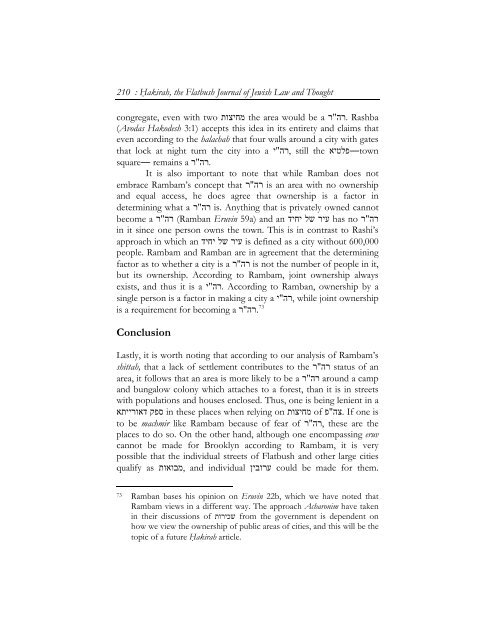King Solomon's Takanah: Rambam's Eruv - Hakirah.org
King Solomon's Takanah: Rambam's Eruv - Hakirah.org
King Solomon's Takanah: Rambam's Eruv - Hakirah.org
You also want an ePaper? Increase the reach of your titles
YUMPU automatically turns print PDFs into web optimized ePapers that Google loves.
הר<br />
210 : Hạkirah, the Flatbush Journal of Jewish Law and Thought<br />
congregate, even with two מחיצות the area would be a "ר .רה Rashba<br />
(Avodas Hakodesh 3:1) accepts this idea in its entirety and claims that<br />
even according to the halachah that four walls around a city with gates<br />
that lock at night turn the city into a "י ,רה still the town―פלטיא<br />
. "ר square― remains a<br />
It is also important to note that while Ramban does not<br />
embrace Rambam’s concept that "ר is an area with no ownership<br />
and equal access, he does agree that ownership is a factor in<br />
determining what a "ר is. Anything that is privately owned cannot<br />
רה has no עיר של יחיד (Ramban <strong>Eruv</strong>in 59a) and an "ר become a<br />
in it since one person owns the town. This is in contrast to Rashi’s<br />
approach in which an עיר של יחיד is defined as a city without 600,000<br />
people. Rambam and Ramban are in agreement that the determining<br />
factor as to whether a city is a "ר is not the number of people in it,<br />
but its ownership. According to Rambam, joint ownership always<br />
exists, and thus it is a "י .רה According to Ramban, ownership by a<br />
single person is a factor in making a city a "י ,רה while joint ownership<br />
73<br />
is a requirement for becoming a .<br />
Conclusion<br />
"ר<br />
רה<br />
רה<br />
רה"ר<br />
רה<br />
רה<br />
Lastly, it is worth noting that according to our analysis of Rambam’s<br />
shittah, that a lack of settlement contributes to the "ר status of an<br />
area, it follows that an area is more likely to be a "ר around a camp<br />
and bungalow colony which attaches to a forest, than it is in streets<br />
with populations and houses enclosed. Thus, one is being lenient in a<br />
. If one is "פ of מחיצות in these places when relying on ספק דאורייתא<br />
to be machmir like Rambam because of fear of "ר , these are the<br />
places to do so. On the other hand, although one encompassing eruv<br />
cannot be made for Brooklyn according to Rambam, it is very<br />
possible that the individual streets of Flatbush and other large cities<br />
qualify as ,מבואות and individual ערובין could be made for them.<br />
צה<br />
רה<br />
רה<br />
רה<br />
73 Ramban bases his opinion on <strong>Eruv</strong>in 22b, which we have noted that<br />
Rambam views in a different way. The approach Acharonim have taken<br />
in their discussions of שכירות from the government is dependent on<br />
how we view the ownership of public areas of cities, and this will be the<br />
topic of a future Hạkirah article.
















